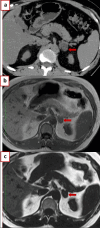Primary aldosteronism diagnosis in the intensive care unit: resistant alkalosis and hypokalemia during severe sepsis with hyperlactatemia: a case report
- PMID: 40281610
- PMCID: PMC12032634
- DOI: 10.1186/s13256-025-05112-6
Primary aldosteronism diagnosis in the intensive care unit: resistant alkalosis and hypokalemia during severe sepsis with hyperlactatemia: a case report
Abstract
Background: Primary aldosteronism screening indications include hypertension (resistant, severe, early onset, with stroke/other comorbidities/sleep apnea), hypokalemia, adrenal incidentaloma, and primary aldosteronism first-degree relatives. We report rare diagnosis of primary aldosteronism in intensive care unit setting, characterized by resistant alkalosis and hypokalemia during severe sepsis with hyperlactatemia.
Case presentation: A 50-year-old Asian-Indian male patient with 18-year history of hypertension (blood pressure 166/104 mmHg) presented with acute septicemia and septic shock following an outpatient urethral dilatation. Despite aggressive management, including intravenous fluids, inotropes, antibiotics, and potassium supplementation, he exhibited severe alkalosis and resistant hypokalemia. Initial laboratory findings showed blood pressure 90/70 mmHg, heart rate 109 beats per minute, pH 7.49, serum lactate 123 mmol/L, sodium 141-144 mmol/L, potassium 2.7-2.9 mmol/L, and creatinine 1.2-1.54 mg/dL (106.1-136.1 µmol/L). Abdominal imaging revealed left adrenal adenoma (20 mm × 19 mm). Patient improved with supportive care and was discharged on day 10 with reinstituted antihypertensive medications. Post-hospitalization, endocrine evaluation confirmed primary aldosteronism with plasma renin activity 0.62 ng/mL/hour, serum aldosterone 43.2 ng/dL (1.20 nmol/L), and aldosterone-renin ratio 69.7. After initiation of spironolactone, blood pressure significantly improved (currently 122/76 mmHg).
Conclusion: Severe sepsis and septic shock in the intensive care unit typically present with metabolic acidosis. This case highlights an atypical presentation of paradoxical, resistant hypokalemia and alkalosis during severe sepsis, leading to a diagnosis of primary aldosteronism. Does the "inbuilt" tendency to metabolic alkalosis in primary aldosteronism confer survival advantage during intercurrent episodes of sepsis and metabolic acidosis? Given the high prevalence of renin-independent aldosterone production and benefits of mineralocorticoid receptor antagonists, universal primary aldosteronism screening for newly diagnosed hypertension appears meritorious and cost-effective.
Keywords: Hyperlactatemia; Hypertension; Hypokalemia; Metabolic alkalosis; Primary aldosteronism; Sepsis.
© 2025. The Author(s).
Conflict of interest statement
Declarations. Ethics approval and consent to participate: Ethical Committee of Samatvam Trust (Science for Health; 2024-07-10) approved this presentation. Consent for publication: Written informed consent was obtained from the patient and patient’s next-of-kin for publication of this case report and any accompanying images. A copy of the written consent is available for review by the Editor-in-Chief of this journal. Competing interests: The authors declare that they have no competing interests.
Figures


Similar articles
-
Severe hydronephrosis complicated with primary aldosteronism: a case report and review of the literature.J Med Case Rep. 2024 Oct 6;18(1):463. doi: 10.1186/s13256-024-04798-4. J Med Case Rep. 2024. PMID: 39369228 Free PMC article. Review.
-
Respiratory failure and rhabdomyolysis caused by severe hypokalemia in a young female with hypertension: a rare critical condition in primary aldosteronism.BMC Urol. 2024 Oct 16;24(1):225. doi: 10.1186/s12894-024-01619-0. BMC Urol. 2024. PMID: 39407241 Free PMC article.
-
Hypokalemia-Induced Rhabdomyolysis Caused by Adrenal Tumor-Related Primary Aldosteronism: A Report of 2 Cases.Am J Case Rep. 2021 Apr 10;22:e929758. doi: 10.12659/AJCR.929758. Am J Case Rep. 2021. PMID: 33838028 Free PMC article.
-
Prevalence of primary aldosteronism among Asian hypertensive patients in Singapore.J Clin Endocrinol Metab. 2000 Aug;85(8):2854-9. doi: 10.1210/jcem.85.8.6752. J Clin Endocrinol Metab. 2000. PMID: 10946893
-
Endocrine and hypertensive disorders of potassium regulation: primary aldosteronism.Semin Nephrol. 2013 May;33(3):265-76. doi: 10.1016/j.semnephrol.2013.04.007. Semin Nephrol. 2013. PMID: 23953804 Free PMC article. Review.
References
-
- Jaffe G, et al. Screening rates for primary aldosteronism in resistant hypertension: a cohort study. Hypertension. 2020;75(3):650–9. 10.1161/HYPERTENSIONAHA.119.14359. - PubMed
-
- Douma S, et al. Prevalence of primary hyperaldosteronism in resistant hypertension: a retrospective observational study. Lancet. 2008;371(9628):1921–6. 10.1016/S0140-6736(08)60834-X. - PubMed
Publication types
MeSH terms
LinkOut - more resources
Full Text Sources
Medical

